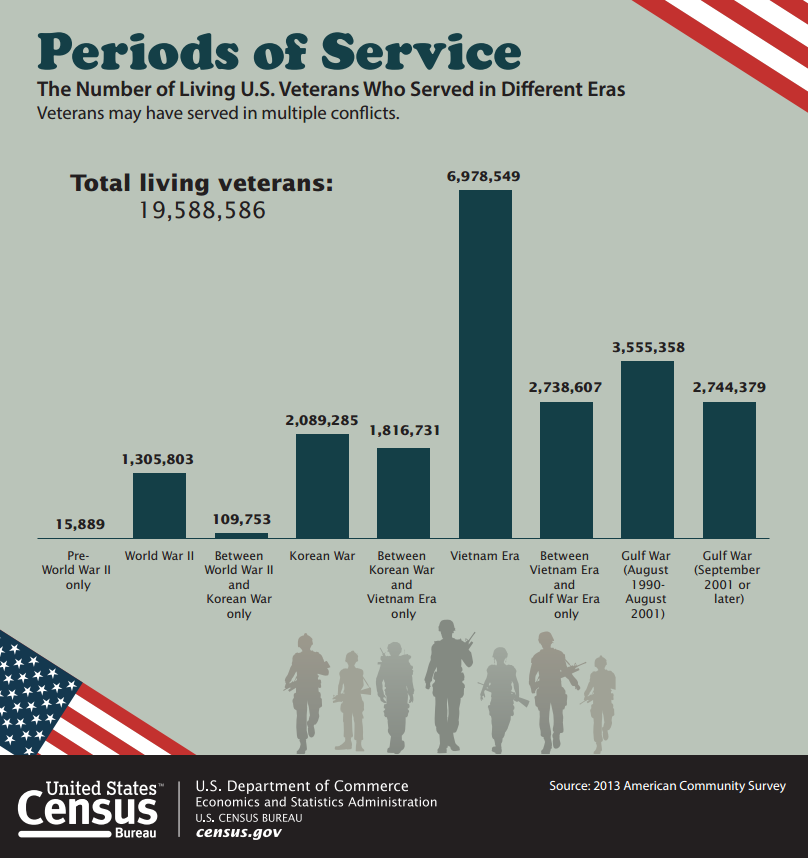 In the United States today, there are more living military veterans than ever before. According to the latest published census in 2014, 19.6 million out of the total 319.2 million Americans are veterans. These men and women have not only sacrificed a great deal defending our country and the freedoms upon which it was founded, they have also accumulated a great many skills and qualities which make them outstanding options as civilian employees. Yet—while their discipline, leadership abilities, and technical skills are widely lauded—military veterans that have served since 2001 have an unemployment rate higher than the national average, one that soars to a staggering 21.4 percent for those between the ages of 18-24.[1]
In the United States today, there are more living military veterans than ever before. According to the latest published census in 2014, 19.6 million out of the total 319.2 million Americans are veterans. These men and women have not only sacrificed a great deal defending our country and the freedoms upon which it was founded, they have also accumulated a great many skills and qualities which make them outstanding options as civilian employees. Yet—while their discipline, leadership abilities, and technical skills are widely lauded—military veterans that have served since 2001 have an unemployment rate higher than the national average, one that soars to a staggering 21.4 percent for those between the ages of 18-24.[1]
Unemployment is not the only challenge American veterans are facing. Approximately 13 percent of veterans report having a service-connected disability. Common injuries incurred by these veterans include missing limbs, burns, spinal cord injuries, PTSD, hearing loss, traumatic brain injuries, and other impairments. Protections like the Veterans and the Americans with Disabilities Act (ADA) ensure that veterans are treated fairly. Many nonprofit organizations also exist to assist veterans who are searching for a job by assisting with interview and resume preparation, matching skills with career placement, and informing them of rights, benefits, etc. Corporations are likewise doing their part to honor the men and women who have served this country—and benefit from their unique experiences and skills—by signing pledges to hire veterans, putting appropriate resources in place, training non-military employees about how to support their colleagues, and much more.
At the 2015 International Corporate Citizenship Conference, we learned a great deal from our member company panelists Altria, Accenture, and Outerwall about how to effectively engage with veterans, including the following key takeaways:
- Companies rightly view veterans as a key asset with essential transferrable skills and are working to match their expertise to fill vital positions.
- Companies are working to build a complete culture that recognizes and values the unique qualities of all of their employees. Veterans are one of many employee groups for whom companies create resources and foster an inclusive culture.
- The needs of veterans are changing, and many difficulties that veterans face are not visible to the naked eye. Companies are increasing their fluency on the resources available and educating their staff so they can provide support.
- Partnerships are a great way to connect and provide benefits to veterans and the company. It is important to choose the right one and establish roles and responsibilities up front.
As with all programs and partnerships, companies must be clear about their goals and objectives as well as the elements by which impact is measured. If you would like to learn more on this topic Center members can access the on-demand webinar. During this one hour presentation Center members Robin Boggs, US Corporate Citizenship Lead at Accenture and Paul Weigel, Director of Community Affairs at Outerwall Inc. discussed in more detail about their success in supporting veterans.
[1]United States Bureau of Labor Statistics. (2014).Table 2A. Employment status of persons 18 years and over by veteran status, age, and period of service, 2013 annual averages [Economic News Release]. Retrieved from http://www.bls.gov/news.release/vet.t02A.htm